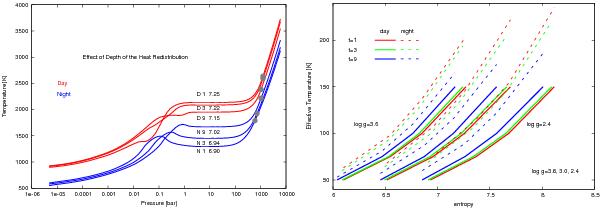Fig. 10

Left: the effect of the depth of the day-night heat transport region on the T − P profile of the atmosphere. The curves are labeled with the values of the Rosseland optical depth of the bottom of the day-night heat transfer region, and the core entropy, respectively. Notice that the entropy on the day side decreases with increasing optical depth. The entropy on the night side behaves in the opposite way, and increases with the optical depth of the heat redistribution region. Right: the effect of the depth of the day-night heat transport on the day-night side cooling. The day-side (solid) and the night-side (dashed) cooling of the planet for three different values of the day-side Rosseland optical depth at the bottom of the heat redistribution region τross = 1,3,9. On the day side, the heat loss increases with increasing optical depth. On the night side, the heat loss decreases with increasing optical depth and this trend tends to dominate the opposite trend on the day side. As a result the night-to-day difference in heat loss is lower for larger optical depth and the total heat loss decreases with increasing the optical depth.
Current usage metrics show cumulative count of Article Views (full-text article views including HTML views, PDF and ePub downloads, according to the available data) and Abstracts Views on Vision4Press platform.
Data correspond to usage on the plateform after 2015. The current usage metrics is available 48-96 hours after online publication and is updated daily on week days.
Initial download of the metrics may take a while.




